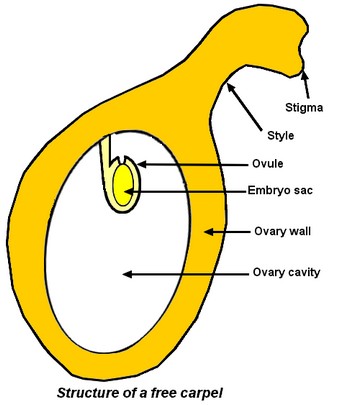A good understanding of carpel organisation is imperative to analyse transformations that occur in an Angiosperm flower after fertilisation to obtain a fruit. A carpel is made of the 3 following parts: – a stigma, a wet surface with papillate cells, that is adapted for the reception and germination of pollen (see pages on pollen), – a style, more or less developed. The pollen tube grows between its cells during the pollen germination (see pages on pollen germination), – and, an ovary, the hollow and basal part of the carpel that contains inside its cavity an ovule (see pages on ovule). Inside ovule, there is the embryo sac (see pages on embryo sac).  Carpels can be free and gynaecium is then apocarpous. If ovaries are entirely fused together, gynaecium is syncarpous (see pages on syncarpous gynaecium). After fertilisation of the egg contained in the embryo sac (see pages on double fertilisation), many transformations occur: – the ovary develops into the fruit and the ovary wall gives the fruit wall (pericarp), – the ovules develop into the seeds and ovule integuments give seed coat, – the fertilised egg develops in the embryo that will be in the seed. Embryo will develop in a new plant during germination.
Carpels can be free and gynaecium is then apocarpous. If ovaries are entirely fused together, gynaecium is syncarpous (see pages on syncarpous gynaecium). After fertilisation of the egg contained in the embryo sac (see pages on double fertilisation), many transformations occur: – the ovary develops into the fruit and the ovary wall gives the fruit wall (pericarp), – the ovules develop into the seeds and ovule integuments give seed coat, – the fertilised egg develops in the embryo that will be in the seed. Embryo will develop in a new plant during germination.
